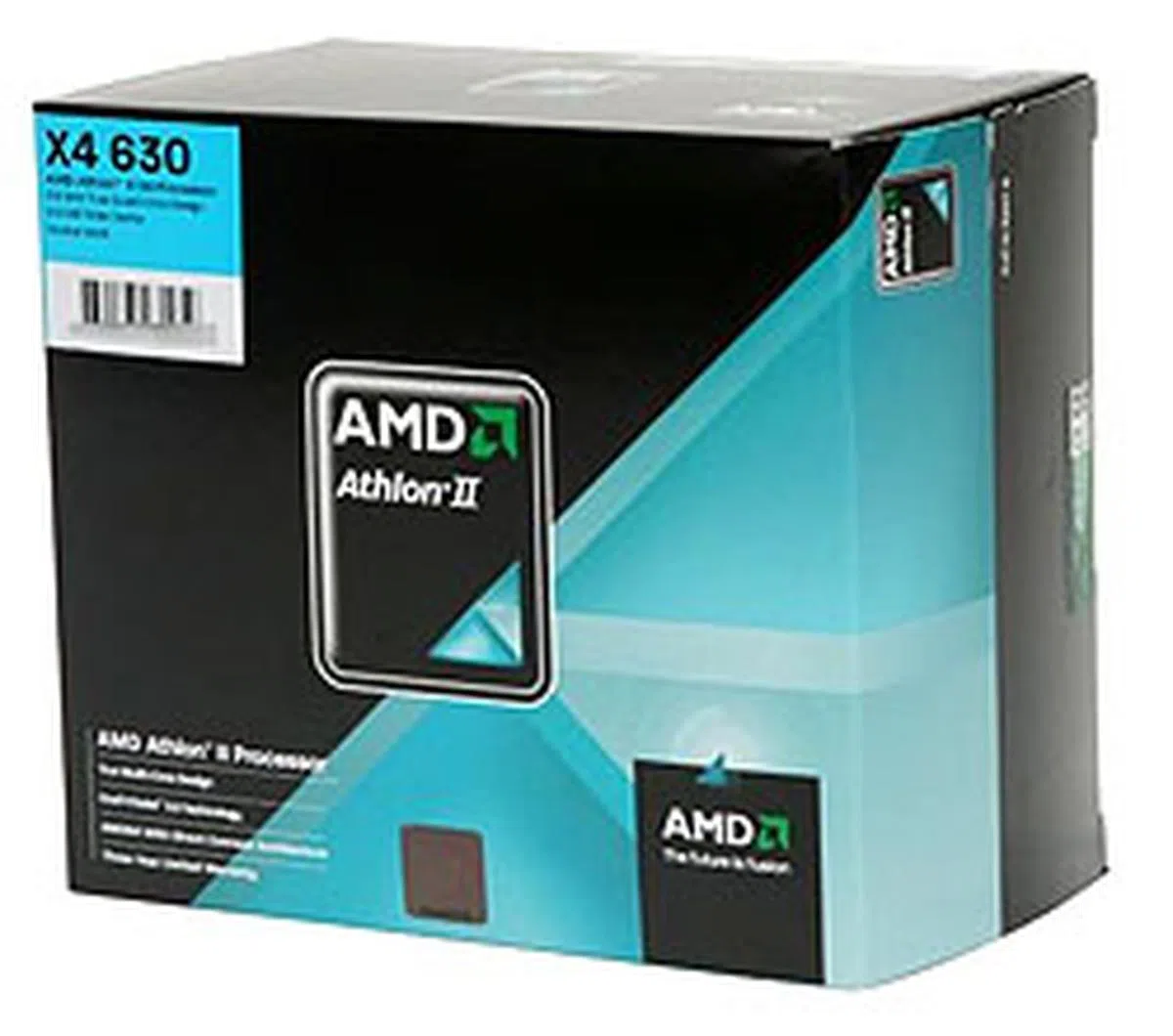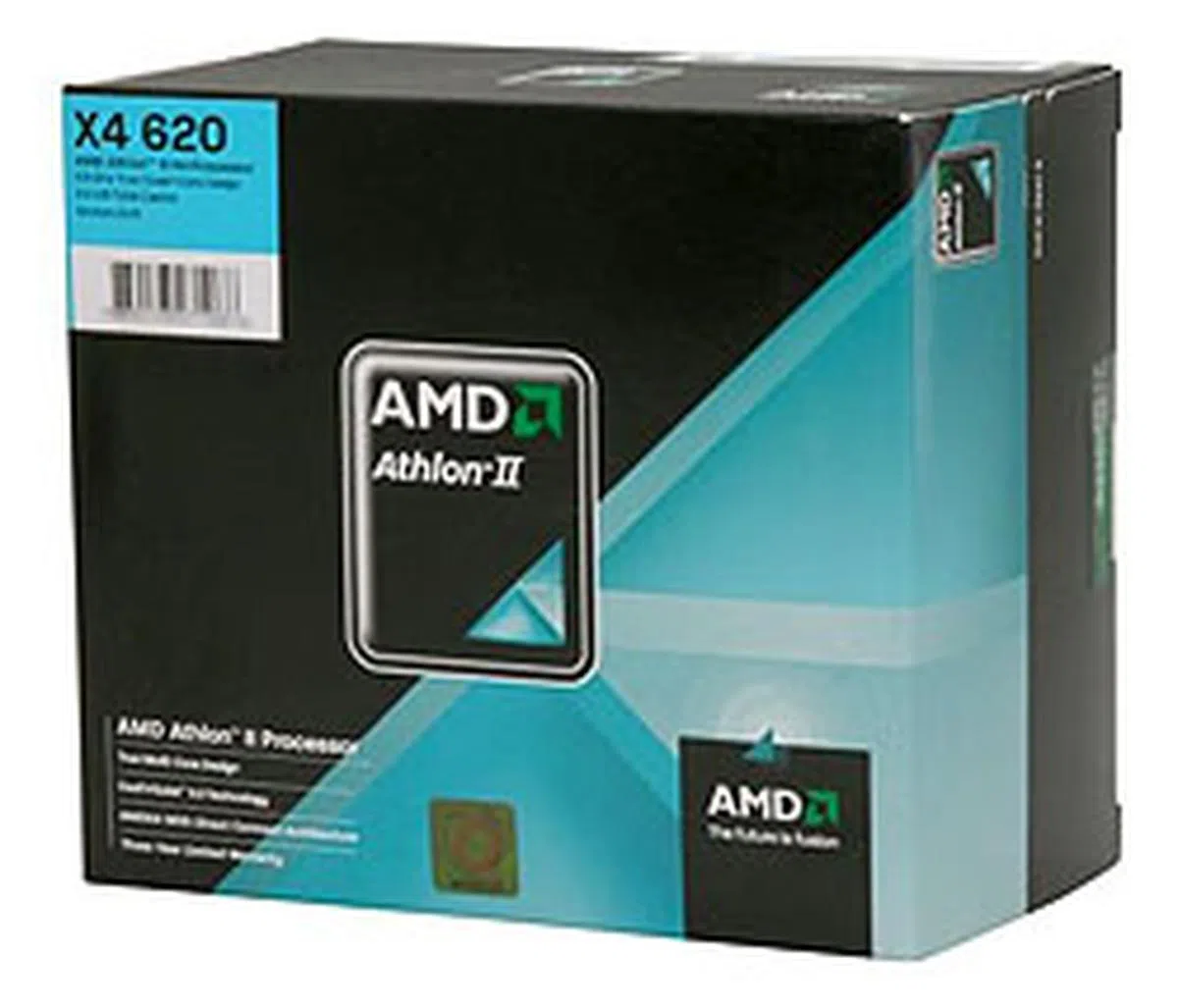The Cheapest Quad-Core Processors - AMD Athlon II X4 630 & 620
Quad-core processors have never been cheaper with AMD's latest processor series, the Athlon II. The Athlon II X4 630 and 620 models are now available, with low prices that Intel's quad-cores cannot match. But do they have the performance to go along with that? Answers in our review.
Relief for AMD
What a November for AMD! Starting with a US$1.25 billion-dollar cash payment from Intel to settle a lawsuit over alleged anti-competitive trade practices, AMD also managed to close all outstanding legal and patent issues with its rival, which means that Intel will not contest AMD's divestment of its manufacturing assets to GlobalFoundries. As the first step towards its financial rehabilitation, AMD seriously needs GlobalFoundries to work and succeed, while the cash from Intel will be very useful as AMD tries to get back into profitability.
And that's not all. The company announced plans for its next-gen CPU architecture, laying out the roadmap to 2011, including the much talked about Fusion initiative, which integrates graphics with the CPU. There are still many questions left unanswered and 'what-if' scenarios but there's no doubt that November has been a great month for AMD. Mind you, we haven't even started on the highs from AMD's graphics division, with the Radeon HD 5800 series stomping uncontested at the top now that the dual-GPU Radeon HD 5970 is available. Or even the recent news that this year's top three supercomputers used AMD's latest six-core 'Istanbul' Opteron processors.
Of course, after the euphoria dies down, the fact remains that it will be a bumpy road to 2011 for AMD. The current CPU microarchitecture is comprehensively outclassed by Intel's Nehalem and with the chip giant going to the 32nm manufacturing node early next year, chances are that AMD will find itself being squeezed out from the middle to the entry/budget and performance computing segments. It is the budget segment that we'll be looking at today, with AMD releasing a cut-down version of its Phenom II processors dubbed the Athlon II.

The AMD Athlon II X4 630 and 620.
This new series will have the most affordable quad-core processors ever, with the lower model, the Athlon II X4 620 going for just US$99. Compare that with Intel's cheapest quad-core, the Q8200 at US$150 and one can see where AMD is going here. Low and lower. How does AMD keep the cost down?
The answer is the removal of the L3 cache that's found on the Phenom II. The entire Athlon II series, which includes dual, triple and quad-cores do not have this cache, allowing AMD to reduce the die size and hence the manufacturing cost. Everything else remains the same, though the Athlon II X4 comes with a lower 95W TDP rating as a result. The new die, Propus, will be used in all Athlon II X4 processors. There's a slim chance that you may get a disabled Phenom II chip when you purchase one of these new Athlon II X4s but as time passes, it will be less and less likely.
Currently, there are only two quad-core models for the Athlon II, the X4 630 and 620. AMD also has two, energy efficient 'e' models that we won't be covering here. These are 45W versions that have much lower clock speeds. Anyway, below are the vital statistics for the X4 630 and 620:
New AM3 Athlon II X4 Processors | ||||||||
Processor Model | Clock Speed | L2 Cache | L3 Cache | HyperTransport Bus | Memory Controller Speed | Max TDP (W) | Retail Price (US$) | Availability |
Athlon II X4 630 | 2.8GHz | 512KB x 4 | NA | 2.0GHz | 2.0GHz | 95 | $123 | Now (PiB) |
Athlon II X4 620 | 2.6GHz | 512KB x 4 | NA | 2.0GHz | 2.0GHz | 95 | $99 | Now (PiB) |
Since the technology is hardly new, we'll be going straight into the testing and benchmarks. For those who are interested in the specifics, we have a table comparing the Phenom II quads with the Athlon II and Intel's Core 2 quad processors on the next page.
Entry Quad Cores Compared
Processor Name | AMD Athlon II X4 | AMD Phenom II X4 | Core 2 Quad |
Processor Models | 630, 620 | 965, 955, 945, 910, 810, 805 | Q9505, Q9400, Q9300, Q8400, Q8300, Q8200 |
Processor Frequency | 2.6GHz - 2.8GHz | 2.5GHz - 3.4GHz | 2.3GHz - 2.83GHz |
No. of Cores | 4 | 4 | 4 |
Front Side Bus (MHz) | - | - | 1333 |
HyperTransport Bus / QuickPath Interconnect | 2.0GHz | 2.0GHz | - |
L1 Cache (data + instruction) | (64KB + 64KB) x 4 | (64KB + 64KB) x 4 | (32KB + 32KB) x 4 |
L2 Cache | 512KB x 4 | 512KB x 4 | 2MB x 2 (Q8xxx), 3MB x 2 (Q9xxx) |
L3 Cache | - | 4MB (810, 805) to 6MB | - |
Memory Controller | Integrated Dual Channel (up to DDR2-1333) | Integrated Dual Channel (up to DDR2-1066) | External - Chipset Dependent |
TDP (W) | 45 - 95 | 95 - 125 | 95 |
Instruction Set Support | MMX, SSE, SSE2, SSE3, SSE4a | MMX, SSE, SSE2, SSE3, SSE4a | MMX, SSE, SSE2, SSE3, SSSE3, SSSE4.1 |
Execute Disable Bit | Yes | Yes | Yes |
Intel EM64T / AMD64 | Yes | Yes | Yes |
Enhanced Intel SpeedStep Technology (EIST) / AMD Cool 'n' Quiet | Yes | Yes | Yes |
Virtualization Technology | Yes | Yes | Yes (No VT for Q8200) |
Packaging | AM3 | AM3 | LGA775 |
Process Technology | 45nm SOI | 45m SOI | 45nm |
Processor Codename | Propus | Deneb | Yorkfield-6M |
Die Size | 169mm² | 258mm² | 164mm² |
No. of Transistors | 300 million | 758 million | 456 million |
Test Setup
As the prices of these new AMD Athlon II X4 quad-core chips are the lowest we have seen for such processors, it's quite difficult to get a straight comparison with Intel. The chip giant's cheapest quad-core CPU for the retail channel is the Core 2 Quad Q8200 (2.33GHz), which by the way, is also the only retail quad-core in its class not to come with virtualization technology support. At around US$150, the Q8200 is almost 30 dollars more than the Athlon II X4 630, but it's the best we have.
While there are few quad-core processors around to match the budget prices that AMD is asking, Intel do have dual-core chips of that range. One model that we believe is a good match for the lower Athlon II X4 620 is the 2.93GHz Pentium Dual-Core E6500, which costs around US$95, just slightly under the 620's US$99 retail price. While under the Pentium Dual-Core brand, this E6500 chip is based on the Core 2 Duo series Wolfdale die, but with a reduced, 2MB L2 cache.
Hence, for our testing, we have two systems (AMD and Intel), with similar amount of memory and the same graphics card and hard drive to keep the results comparable. Both were running Windows XP SP2. The full system configurations are as follows:
AMD Athlon II X4 Test Configuration
- CPU:- Athlon II X4 630 & 620
- MSI 790FX-GD70 (AMD 790FX + SB750)
- 2 x 1GB Kingston HyperX DDR3-1333 (7-7-7-20)
- Seagate Barracuda 7200.10 200GB SATA hard drive (one single NTFS partition)
- Zotac GeForce GTX 260 (ForceWare 178.24)
- Microsoft Windows XP Professional with Service Pack 2
Intel System Test Configuration
- CPU:- Core 2 Quad Q8200, Pentium Dual-Core E6500
- ASUS P5E3 Deluxe (Intel X38 Express chipset)
- 2 x 1GB Kingston HyperX DDR3-1333 memory modules (CAS 7-7-7-20)
- Seagate Barracuda 7200.10 200GB SATA hard disk drive (one single NTFS partition)
- Zotac GeForce GTX 260 (ForceWare 178.24)
- Microsoft Windows XP Professional with Service Pack 2
- Intel INF 8.3.1.1009 and Matrix Storage Manager 7.8.0.1012
Benchmarks
The following benchmarks were used in this review:
- BAPCo SYSmark 2007 Preview (ver 1.05)
- Futuremark PCMark 2005 Pro
- Lightwave 3D 7.5
- 3ds Max8 (SP2)
- Cinebench 10
- Futuremark 3DMark06 v1.1
- AquaMark3
- World in Conflict v1.05
- Crysis v1.1
Results - SYSmark 2007 Preview
At 2.33GHz, Intel's Q8200 is not the fastest of processors, even among the generally slower quad-cores, but it still managed to edge the higher clocked Athlon II processors. Naturally, this advantage was not unexpected due to the different architectures but the surprise however was seeing the cheapest processor of all, the Pentium Dual-Core E6500 taking the top spot here, no doubt aided by its high clock speeds.
With the exception of the video creation segment, which it was understandably weaker in, the E6500 was significantly faster than the quad-cores. Interestingly, the Athlon II X4s were quite competitive in video creation and 3D, as even the 620 managed to beat the Q8200.


Results - Futuremark PCMark05 Pro
Continuing with the positive vibe we seem to be getting from these AMD processors, they beat the Intel contingent in the CPU segment of PCMark05. The memory portion was slightly more competitive but in the end, the Athlon II X4 630 pulled ahead by a narrow margin over the Pentium Dual-Core.


Results - Lightwave 3D 7.5
Lightwave 3D was the perfect example of the competitiveness these entry level quad-core processors from AMD compared to Intel's equivalent. In both benchmarks tested, both Athlon II X4 processors were faster than the Q8200, including the slower 620 model. And while Intel could point to the Pentium Dual-Core's performance with pride, it too gets limited by its number of cores as the number of concurrent threads increase.


Results - 3ds Max 8 (SP2) and Cinebench 10
Like Lightwave, our initial experience with the AMD Athlon II X4 in 3ds Max 8 was a positive one, with both models taking less time than Intel's Q8200 to complete the rendering. The second, which involved radiosity saw the Pentium Dual-Core beating all the quad-cores here. AMD also performed badly in this benchmark, which was not surprising since we have seen similar results from the Phenom II family before.


The other rendering benchmark is Cinebench 10, which taxed the maximum number of cores on the processors. Obviously, even the higher clock speed of the Pentium Dual-Core counts for naught here. The Athlon II X4 remained competitive, with the 630 marginally losing to the Q8200.

Results - Futuremark 3DMark06 & AquaMark3
These new AMD processors also impressed us in 3DMark06, with higher overall and CPU scores than its Intel rivals. AquaMark3 however appeared to favor the higher clock speed of the Pentium Dual-Core as it topped this benchmark, with the Athlon II X4 processors falling slightly behind the Q8200. Given that this benchmark is mostly single-threaded, we aren't too surprised that the quad-cores did not perform here.




Results - World in Conflict & Crysis
Next, in World in Conflict, we found the AMD contingent matching Intel, though the Q8200 was slightly faster. Crysis however saw the Intel processors doing better generally, as even the Pentium Dual-Core managed higher frame rates. Nevertheless, the AMD processors were not too far off and coupled with a decent graphics card (our settings were low enough that the GPU would not be a bottleneck), it should be competitive enough with Intel.


Power Consumption
With its smaller die, 45nm manufacturing process, and of course the latest evolution of AMD's Cool'n'Quiet technology, we were expecting these Athlon II X4 processors to have very decent power consumption. At idle, this was more or less the case, with the AMD processors on par with Intel's. However, once we started taxing them, the power meter jumped up and at the end of our testing, the Athlon II X4 processors took in more power than its Intel competitors. To be fair, they have higher clocks than the Q8200 while the dual-core processor obviously was always going to consume less power.



Overclocking
Overclocking is next and we managed to get the Athlon II X4 630 up to 3.9GHz on air-cooling, just by pushing the bus speed. This was achieved by having a bus speed of 280MHz and a multiplier of 14. The 620 too had similar tolerance, reaching 3.6GHz (280 x 13). At these overclocked speeds, the Athlon II X4s were beating the Intel processors.

Conclusion
The recent arrival of Intel's Lynnfield based Core i7 and i5 processors has further dented AMD's hopes of expanding in the mainstream with its Phenom II processors. AMD's top Phenom II, the X4 965, barely keeps up with these newcomers as the Phenom II's sole remaining advantage of being the better bang for buck choice is greatly reduced with the more affordable price tags attached to the Lynnfield processors and the supporting Intel P55 chipset.
Hence, the drive to delve even deeper into the budget segment, with the cheapest ever quad-cores in the market and more triple-cores launched under the Athlon II brand. Going under US$100 may be a milestone in the retail channel but the important thing is whether these Athlon II X4 processors are good?
From what we have seen, they are no chart toppers when it comes to their quad-core performance but they certainly punch above their weight and price. Compared to Intel's cheapest quad-core, the Q8200, we found the two Athlon II X4s to be very competitive, especially when it comes to the more intensive video and 3D applications that one usually recommends a quad-core processor for. Not only do they get the nod from us for its performance and price, their idle power draw is commendable; although full-load power draw have room for improvement yet.
The problem however is that Intel has many dual-core offerings that remain very capable in these price brackets. Like the Pentium Dual-Core E6500 that we featured as a comparison, these dual-core processors make up for their lack of cores with higher clocks and the fact that truly multi-threaded applications are not exactly that common yet. This helps these dual-cores stay relevant, even though it, like the Core 2 Quad, has no upgrade prospects. If you're looking to trade up in the future, Intel's Core 2 offerings are a big no.
Overall, we feel that these entry level quad-cores have a place for budget conscious users. The AMD platform is already quite affordable and these processors make it even better. One could overcome any shortcomings with a faster graphics cards or even a solid state drive with the added savings. The fact is that processors are no longer the biggest bottleneck in many new systems and there are options to tweak your system build to fit a budget better. Overclocking these relatively inexpensive processors is another route that enthusiasts may take and from our testing, it too looks promising.
 | |
 |
Our articles may contain affiliate links. If you buy through these links, we may earn a small commission.
